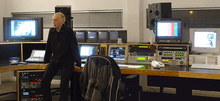Video editing
The term video editing can refer to: The process of manipulating video images. Once the province of expensive machines called video editors, video editing software is now available for personal computers and workstations. Video editing includes cutting segments (trimming), re-sequencing clips, and adding transitions and other Special Effects.[1]
- Linear video editing, using video tape and is edited in a very linear way. Several video clips from different tapes are recorded to one single tape in the order that they will appear.
- Non-linear editing system (NLE), This is edited on computers with specialised software. These are non destructive to the video being edited and use programs such as Adobe Premiere Pro, Final Cut Pro and Avid.
- Offline editing is the process in which raw footage is copied from an original source, without affecting the original film stock or video tape. Once the editing has been completely edited, the original media is then re-assembled in the online editing stage.
- Online editing is the process of reassembling the edit to full resolution video after an offline edit has been performed and is done in the final stage of a video production.
- Vision mixing, when working within live television and video production environments. A vision mixer is used to cut live feed coming from several cameras in real time.
Background
Video editing is the process of editing segments of motion video production footage, special effects and sound recordings in the post-production process. Motion picture film editing is a predecessor to video editing and, in several ways, video editing simulates motion picture film editing, in theory and the use of linear video editing and video editing software on non-linear editing systems (NLE). Using video, a director can communicate non-fictional and fictional events. The goals of editing is to manipulate these events to bring the communication closer to the original goal or target. It is a visual art.[2]
Early 1950's video tape recorders (VTR) were so expensive, and the quality degradation caused by copying was so great, that 2 inch Quadruplex videotape was edited by visualizing the recorded track with ferrofluid and cutting with a razor blade or guillotine cutter and splicing with video tape. The two pieces of tape to be joined were painted with a solution of extremely fine iron filings suspended in carbon tetrachloride, a toxic and carcinogenic compound. This "developed" the magnetic tracks, making them visible when viewed through a microscope so that they could be aligned in a splicer designed for this task.
Improvements in quality and economy, and the invention of the flying erase-head, allowed new video and audio material to be recorded over the material already recorded on an existing magnetic tape and was introduced into the linear editing technique. If a scene closer to the beginning of the video tape needed to be changed in length, all later scenes would need to be recorded onto the video tape again in sequence. In addition, sources could be played back simultaneously through a vision mixer (video switcher) to create more complex transitions between scenes. A popular 1970-80s system for doing that was the U-matic equipment (named for the U-shaped tape path). That system used two tape players and one tape recorder, and edits were done by automatically having the machines back up, then speed up together in synchrony, so the edit didn't roll or glitch. Later, 1980-90's came the smaller beta equipment (named for the B-shaped tape path), and more complex controllers, some of which did the synchronizing electronically.

There was a transitional analog period using multiple source videocassette recorder (VCR)s with the EditDroid using LaserDisc players, but modern NLE systems edit video digitally captured onto a hard drive from an analog video or digital video source. Content is ingested and recorded natively with the appropriate codec which will be used by video editing software to manipulate the captured footage. High-definition video is becoming more popular and can be readily edited using the same video editing software along with related motion graphics programs. Video clips are arranged on a timeline, music tracks, titles, digital on-screen graphics are added, special effects can be created, and the finished program is "rendered" into a finished video. The video may then be distributed in a variety of ways including DVD, web streaming, QuickTime Movies, iPod, CD-ROM, or video tape.
Home video editing
Like many other technologies, the cost of video editing has declined by an order of magnitude or more. The 2" Quadruplex system cost so much that many television production facilities could only afford a single unit and editing was a highly involved process requiring special training. In contrast, nearly any home computer sold since the year 2000 has the speed and storage capacity to digitize and edit standard-definition television (SDTV). The two major retail operating systems include basic video editing software - Apple's iMovie and Microsoft's Windows Movie Maker. Additional options exist such as more advanced commercial products, as well as there are free opensource[3] video-editing programs. Automatic video editing products have also emerged, opening up video editing to a broader commercial audience of amateurs and reducing the time it takes to edit videos.
See also
- Edit decision list
- Video mashups
- Photo slideshow software
- Video scratching
- Video server
- List of video editing software
- Comparison of video editing software
References
- ↑ "What is video editing?". Webopedia. Retrieved 26 February 2014.
- ↑ http://web.archive.org/web/20120301084719/http://www.videouniversity.com/articles/the-art-of-film-and-video-editing-part-1/
- ↑ "Best free video editing software". TechRadar. Retrieved 7 June 2013.
External links
![]() Media related to Video editing at Wikimedia Commons
Media related to Video editing at Wikimedia Commons